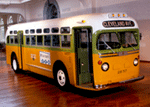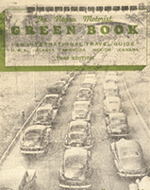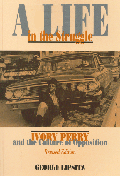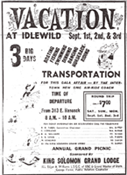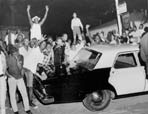
Driving While Black: The Car and Race Relations in Modern America
The Car and Jim Crow
For blacks, as well as for whites, cars had real practical value--as a means of getting to work, of travelling, of visiting family and friends. But cars had other, deeper meanings for many African Americans. Perhaps most importantly, they helped blacks to escape the insults of Jim Crow.
From the late nineteenth century through the civil rights revolution of the 1950s and 1960s, American blacks faced some of the harshest indignities of legal segregation on buses, streetcars, and trains. In the South, black patrons at bus and train stations were cordoned off into separate waiting rooms, with separate bathrooms, drinking fountains, and (when they were provided to blacks at all) separate concession stands. On trains, they were confined to separate, inferior Jim Crow cars. In railroad dining cars, a curtain separated black passengers from whites. On urban public transportation, black and white passengers were separate and unequal. Black passengers were required to sit at the back of buses and trolleys--and to give up their seats to whites on demand. Black passengers who challenged Jim Crow on public transportation systems faced insult, personal injury, arrest, and even death at the hands of angry whites.
The car provided southern blacks a way to subvert Jim Crow. As Gunnar Myrdal noted in his exhaustive study of black America published in 1944, "the coming of the cheap automobile has meant for Southern Negroes, who can afford one, a partial emancipation from Jim Crowism." Blacks who could afford to travel by car did so as a way of resisting the everyday racial segregation of buses, trolleys, and trains, for as one observer noted, "Race is most completely ignored on the public highway.... Effective equality seems to come at about twenty-five miles an hour or above." In 1936, sociologist Arthur Raper, who studied race relations in rural Georgia, noted that the "opportunities provided by the automobile provide a basis for a new mobility for whites as well as Negroes, based upon personal standards rather than upon community mores--upon which the individual wants to do rather than what the community does not want him to do." Driving gave southern blacks a degree of freedom that they did not have on public transportation or in most public places.
For all of the "new mobility" of the car, driving still posed difficulties for blacks. African American travelers regularly carried buckets or portable toilets in their car trunks because service station bathrooms and roadside rest areas were usually closed to them. Black motorists also found it difficult to find places to stay: most roadside motels--north and south--refused to admit blacks. Diners and fine restaurants alike regularly turned away black customers. By the 1930s, however, black motorists could consult guidebooks to make their way through the countryside with as few hassles as possible. The first of the genre, the Negro Motorist Green Book, in 1936, promised to provide "the Negro traveler information that will keep him from running into difficulties, embarrassments, and to make his trip more enjoyable." Black newspapers also ran advertisements for "race" hotels, restaurants, and resorts where black customers were welcome.
Traveling on back roads brought other dangers for the black motorist. The phenomenon of being stopped for "driving while black" did not begin with New Jersey in the 1990s. Throughout the twentieth century, black drivers regularly complained that they were harassed by police officers. It was commonplace advice that black motorists should drive below the posted speed limit--but not too slow as to attract attention--because police officers would regularly stop blacks for traveling even one mile an hour faster than what was posted. Some black drivers took road trips at night, when it was harder for police to identify them by skin color as they drove down dark country roads. Interracial travel was especially dangerous, especially in the South. Blacks who drove with whites in the same car put themselves at risk of arrest or violence. Only when it was clear that the black driver was a chauffeur could blacks and whites share the same car without arousing suspicion. When black and white civil rights activists took the risk of driving together through the south, whites usually sat in the back with a single black driver in the front to fool the police.
As the battle for racial equality heated up in the 1950s and the 1960s, cars became battlegrounds over the future of racial equality. Cars provided a means for black opponents of Jim Crow to escape violence. When he testified against whites who had lynched his nephew Emmett Till in 1955, Mose Wright was whisked out of Mississippi by car under the cover of darkness. The memoirs of civil rights activists are full of stories about the terror of driving down dark country roads, of ducking to avoid being seen by passing whites, of being followed by unidentified cars, and of taking long detours to avoid the police. Not all of the automobile stories had happy endings. During the summer of 1964, three young civil rights activists, Michael Schwerner, James Chaney, and Andrew Goodman, were followed by white racists, dragged from their car, and murdered. The charred hulk of their car was found submerged in a swamp.
Outside the South, particularly during the racial struggles of the 1960s, confrontations between blacks and the police often centered around cars. In the summer of 1964, the urban uprising in Watts, a neighborhood in south-central Los Angeles, an expression of deeply-rooted grievances about the economy and second-class status among the city's segregated black community, was sparked by a clash between blacks and the police who had pulled over a black woman suspected of driving under the influence. In Watts, as in the hundreds of civil disturbances in American cities during the 1960s, random car stops and searches and roadblocks were an essential part of riot control. Civil rights and black power protestors in the 1960s also incorporated the automobile into their protest strategies. On the opening day of the 1964 World's Fair, New York civil rights activists held a controversial (but unsuccessful) "stall in" on the expressway leading to the fairgrounds. Cars became the vehicles for protest and racial conflict alike.
<<Previous Section - Next Section>>
Introduction
The Car and Jim Crow
"Drivin' Down the Freeway": Blacks and Car Culture
Image Versus Reality
On the Line: Blacks and Auto Work
For Further Reading
Complete Text Printable View
About the Project | Credits | Contact Us | Student & Teacher Resources | Site Map
©2004-2010 Automobile in American Life and Society
